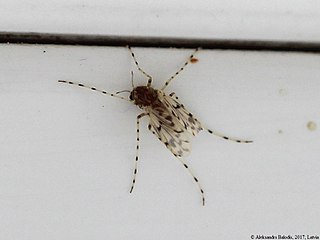
The Chironomidae comprise a family of nematoceran flies with a global distribution. They are closely related to the Ceratopogonidae, Simuliidae, and Thaumaleidae. Many species superficially resemble mosquitoes, but they lack the wing scales and elongated mouthparts of the Culicidae.
Conchapelopia is a genus of flies belonging to the family Chironomidae.

The genus Axarus is widely distributed with records from the Holarctic, the Neotropics and Australasia . There are currently 5 described nearctic species . Erected as a subgenus (Anceus) of Xenochironomus , Axarus was subsequently renamed and elevated to generic status . The Connecticut River in the eastern United States harbors locally dense populations of two Axarus species, both currently undescribed. These populations are interesting in that they are restricted to specific larval habitat and thus there is genetic structure between populations in the river . The Connecticut River species are also notable in that they have extremely well developed polytene chromosomes and also maintain a high degree of inversion polymorphism .

Ablabesmyia is a genus of non-biting midges in the subfamily Tanypodinae of the bloodworm family Chironomidae.

Brillia is a genus of non-biting midges in the subfamily Orthocladiinae of the family (Chironomidae).
Corynoneura is a speciose genus of non-biting midges in the subfamily Orthocladiinae of the bloodworm family Chironomidae. With a world-wide distribution, these small midges are found in both flowing and standing freshwater of various thermal regimes.

Cricotopus is a genus of non-biting midges in the subfamily Orthocladiinae of the bloodworm family Chironomidae.

Metriocnemus is a genus of non-biting midges in the subfamily Orthocladiinae of the bloodworm family Chironomidae.

Chironominae is a subfamily of midges in the non-biting midge family (Chironomidae).

Chironomini is a tribe of midges in the non-biting midge family (Chironomidae).

Polypedilum is a genus of non-biting midges in the subfamily Chironominae of the bloodworm family Chironomidae. This is probably the most species-rich of all chironomid genera. Larvae of Polypedilum may also be among the most abundant invertebrates in eutrophic ponds, reaching densities of up to 1200 larvae per square meter.

Tanytarsini is a tribe of midges in the non-biting midge family (Chironomidae).

Tanypodinae is a subfamily of midges in the non-biting midge family (Chironomidae). The larvae are generally carnivorous and their mouthparts are adapted for predation on small invertebrates although 1st and 2nd instar larvae also feed on algae.

Trissopelopia is a genus of non-biting midges in the subfamily Tanypodinae of the bloodworm family Chironomidae.

Procladius is a genus of non-biting midges in the subfamily Tanypodinae of the bloodworm family Chironomidae.
Tanypodini is a tribe of midges in the non-biting midge family (Chironomidae).
Macropelopiini is a tribe of midges in the non-biting midge family (Chironomidae).
Pentaneurini is a tribe of midges in the non-biting midge family (Chironomidae).
Diamesini is a tribe of midges in the non-biting midge family (Chironomidae).










